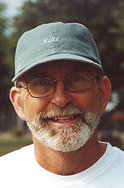June 2008 Article Tennis Anyone Archives:
Tennis Server
|

 |
On your forehand ground stroke, keep your non-dominant hand out in front. On your serve and overhead, keep your non-dominant hand up high as long as possible. This will help you judge the distance and height of the ball. If you have a two-handed backhand and you are running a great distance to chase a ball, run like a runner, free handed, until you get closer to the ball. If you run with your hands on the racket it can look awkward and slow you down. Most players think that their racket turns in their hands because they are holding it too loose. Quite the contrary, you seldom have to grip the racket tight on any shot. Not looking at the ball, not hitting the ball squarely and bad footwork are more to blame. When not hitting the ball, keep the weight of the racket in your non-dominant hand. This will help relax your dominant hand and allow much better grip changes. In doubles, a very common mistake when receiving a very short ball is to run fast and hit the ball deep. Of course, your opponent will see your dilemma and throw up a lob over your head. So, if you are comfortable hitting overheads, this is a good tactic. If you are not comfortable with overheads, then return the short ball with another short ball (dink). When poaching in doubles, try not to think about doing it just when everything is perfect. It may never be perfect. Move your feet and racket in the direction of the ball all the time. This will train your partner to watch the ball and not expect you to hit it. Also, your opponents will be kept off guard by the constant movement. In doubles, anytime you or your partner hit a lob, which your opponents allow to land, move forward toward the service line to take the offense. Most players will return the lob with a lob, so you will be in a great position to hit an offensive overhead. When you are returning a serve, always think, "I want to hit a forehand." When coming to the net, always expect a lob first, a backhand volley second and a forehand volley third. Move at least 3 steps before giving up on any shot. Always be in a position to play the ball before you call it out. That way, if the shot unexpectedly lands in, you can make a play on it. It is not old-fashioned to call the score out loud and to make audible out calls. In doubles, keep the ball low and keep the ball landing at your opponents feet. In singles and doubles, the majority of all shots should go cross-court. The player that changes the direction of the ball most usually loses. When you are being attacked, send the ball back in the direction the ball is coming from. Change the direction of the ball more often when you are in the offense. Good luck on the courts!
1994 - 2002 | 2003 - Present
This column is copyrighted by John Mills, all rights reserved.
John Mills' experience includes four years as head pro at the Windemere Racquet & Swim Club, where he was responsible for organization of all tennis activities at the club. John also played college tennis at the University of Houston and has spent 20 years teaching tennis at the Memorial Park Tennis Center, the Pasadena Racquet Club, and as the head pro at the Bay Area Racquet Club.
|
 You will join 13,000 other subscribers in receiving news of updates to the Tennis Server along with monthly tennis tips from tennis pro Tom Veneziano.
You will join 13,000 other subscribers in receiving news of updates to the Tennis Server along with monthly tennis tips from tennis pro Tom Veneziano. 


